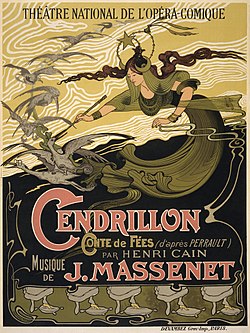Cinderella

"Cinderella, or The Little Glass Slipper" [1] is a fairy tale by Charles Perrault. It was first published anonymously in Paris in 1697 in Histoires ou contes du temps passé (English: [Stories or Tales of Past Times] Error: {{Lang}}: text has italic markup (help)), a collection of eight fairy tales by Perrault.[2][3]
The story is about an ill-treated girl who, with the help of her fairy godmother, travels to a ball in a pumpkin coach. She flees the ball at midnight and loses her glass slipper. A prince, who has fallen in love with her, finds her lost slipper and uses it later to find her.
Similar European tales are found in Bonaventure des Periers's New Recreations and Joyous Games (1558) and Giambattista Basile's Pentamerone (1634-6). The Brothers Grimm included their version, "Aschenputtel", in Children's and Household Tales (1812). Tales similar to "Cinderella" exist in Chinese, Indian, African, Javanese, Australian, and Japanese literature and folklore. The tale has been adapted to the stage, movies, television, and other media.[4]
Story
A widower marries a proud and haughty woman. She already has two daughters of her own. They despise the man's daughter by his first marriage, but she is gentle and beautiful, They treat her meanly. She is assigned all the housework and sleeps in the attic. She gave her the name Cinderella because she sits in the chimney corner.
A prince gives a ball and all the ladies of quality are invited. Cinderella's stepsisters go to the ball, but Cinderella remains at home crying. Her fairy godmother appears and transforms a pumpkin into a golden coach to take Cinderella to the ball. The fairy turns mice, lizards, and a rat into horses and coachmen with a wave of her wand. She gives Cinderella a gown of gold and silver and slippers made of glass. She orders Cinderella to return home by midnight for the charm ends at that time. Cinderella goes to the ball and dazzles everyone. The prince pays her special attention. Her stepsisters do not recognize her. She leaves at midnight and returns home. The next evening she again goes to the prince's ball. She loses track of time, hurries away just at midnight, but loses one of her glass slippers. At home, Cinderella's gown turns to rags, but the other glass slipper remains as it is.
The stepsisters tell her that the prince is in love with the unknown beautiful lady. The prince orders the slipper to be tried on all the ladies in the land. He will marry only the girl whose foot will fit the slipper. The stepsisters try it on but it does not fit. Cinderella tries it on and it fits. She pulls the other slipper from her pocket and puts it on. The Godmother appears and touches Cinderella's clothes with her wand. They are transformed into a gown more beautiful than that she wore to the ball. A few days later, the prince marries her. She forgives her stepsisters for their past meanness and finds husbands for them at the court.
References
- Betts, Christopher. 2009. The Complete Fairy Tales. Oxford UP. ISBN 978-0-19-923683-1
- Opie, Iona and Peter. 1974. The Classic Fairy Tales. Oxford UP. ISBN 0-19-211559-6.
- Zipes, Jack (Ed.) 2000. The Oxford Companion to Fairy Tales. Oxford UP. ISBN 0-965-36357-0

